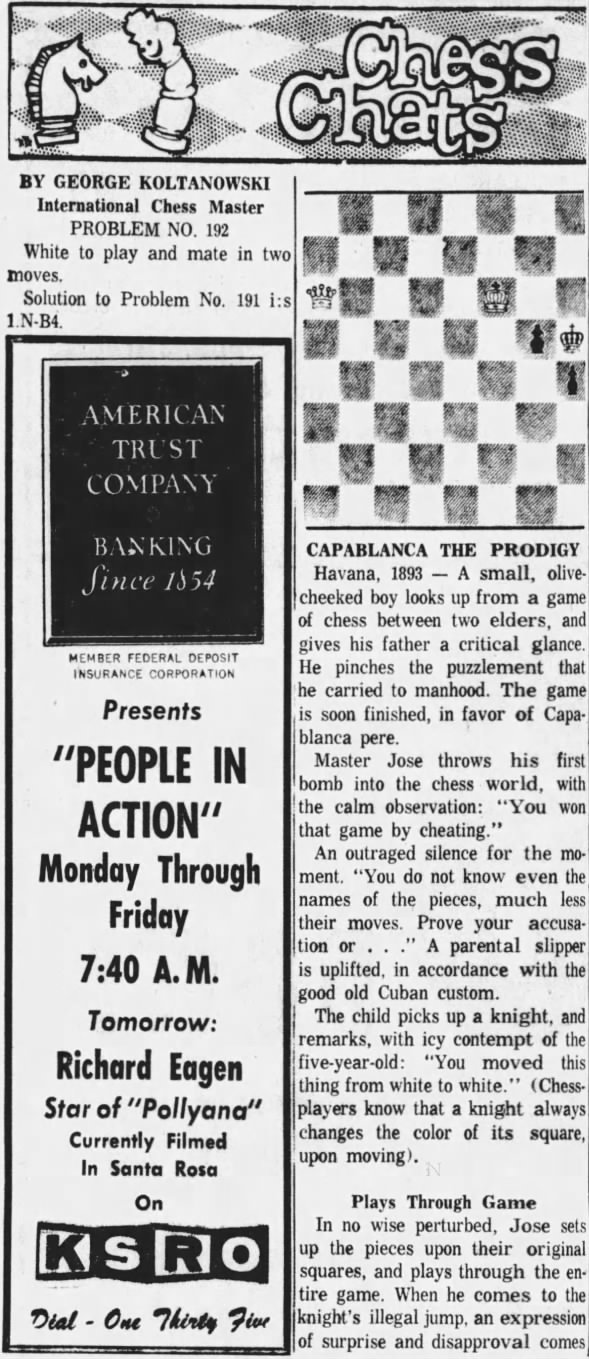
 Chess Chats 09 Aug 1959, Sun The Press Democrat (Santa Rosa, California) Newspapers.com
Chess Chats 09 Aug 1959, Sun The Press Democrat (Santa Rosa, California) Newspapers.com
Chess Chats by George Koltanowski
International Chess Master
The Press Democrat Chess Chats by George Koltanowski, Sunday, August 09, 1959, Santa Rosa, California Problem No....
Posted by Bobby Fischer's True History on Monday, April 4, 2022
Problem No. 192
White to play and mate in two moves.
FEN 8/8/Q4K2/6pk/7p/8/8/8 w - - 0 1
Solution: Q-B8; 1. Qc8 Kh6 2. Qh8#
CAPABLANCA THE PRODIGY
Havana, 1893—A small, olive-cheeked boy looks up from a game of chess between two elders, and gives his father a critical glance. He pinches the puzzlement that he carried to manhood. The game is soon finished, in favor of Capablanca pere.
Master Jose throws his first bomb into the chess world, with the calm observation: “You won that game by cheating.”
An outraged silence for the moment. “You do not know even the names of the pieces, much less their moves. Prove your accusation or …” A parental slipper is uplifted, in accordance with the good old Cuban custom.
The child picks up a knight, and remarks, with icy contempt of the five-year-old: “You moved this thing from white to white.” (Chessplayers know that a knight always changes the color of its square, upon moving).
Plays Through Game
In no wise perturbed, Jose sets up the pieces upon their original squares, and plays through the entire game. When he comes to the knight's illegal jump, an expression of surprise and disapproval comes into his large eyes. How well we came to know that expression which asks: “Why can't you be logical?” in after-years.
The slipper falls upon the carpet. A wondering father takes refuge in irony: “Since you know so much about it, perhaps you would like to play me a game?” Of course. And, of course, Jose wins.
Heroes of infantile-prodigious stories are plentiful in chess history, but none of them began so young as Jose Raoul Capablanca, born at Havana in 1889. The late Richard Reti attributed Capablanca's almost automatic precision (amounting to intuition) in end-game positions, to his early familiarity with the pieces, accompanied by a geometrical faculty that made the two-dimensional chessboard a simple plaything.
Capablanca won the chess championship of Cuba at the age of 12. In 1921 the championship of the world, and the young prodigy had at last arrived at his goal.
Played in the recent Claire Benedict tournament, Switzerland.
Arturo Pomar Salamanca vs Wolfgang Unzicker
Clare Benedict Cup 06th (1959), Lugano SUI, rd 4, Mar-18
King's Indian Defense: Pomar System (E72) 1-0
a) Well played. If Black wishes to gain the pawn on B4, he has to exchange his Black bishop and give White full control of the board.
b) Must look for counter-chances with RxP.
(c) The general exchange has left White a pawn up with no compensation for Black.
(d) If 27. … RxP; 28. R-N7 etc.
(e) A strongly played game by the former Spanish boy-wonder.
 Players Warm Up 09 Aug 1959, Sun The Press Democrat (Santa Rosa, California) Newspapers.com
Players Warm Up 09 Aug 1959, Sun The Press Democrat (Santa Rosa, California) Newspapers.com
PLAYERS WARM UP for today's Valley of the Moon Chess Festival play with a Round Robin tournament. In the Round Robin everyone in each class plays everyone else in that class and points are awarded for wins. High point man is top dog. Round Robin play consists of four classes—Expert, Class A, Class B and, Class C. The Round Robin opened the three-day chess event in Sonoma, which winds up with the Chess Festival play today, in which 250 players are expected to participate.
 Arizona State 09 Aug 1959, Sun The Press Democrat (Santa Rosa, California) Newspapers.com
Arizona State 09 Aug 1959, Sun The Press Democrat (Santa Rosa, California) Newspapers.com
ARIZONA STATE Women's Chess Champion Mrs. Elmer Burlingame, Phoenix, Ariz., contemplates a move in match with unidentified opponent at Valley of the Moon Chess Festival.






















